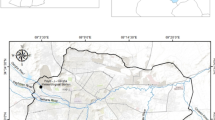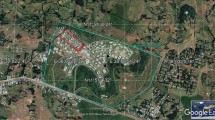Abstract
Water scarcity is a big obstacle for develo** urban landscapes in cities located in arid and semiarid areas. This issue is very critical in most parts of Iran including city of Malayer. Despite a high rate of physical development, Malayer University campus is suffering from a lack of sustainable water resources for landscape irrigation. Therefore, finding a sustainable water resource for this campus is crucial. Rainwater harvesting system, as an acceptable water resource management method, can be considered as an alternative method for landscape irrigation. Hence, the aim of this study is to determine the suitability and estimate the amount of collectible rainwater in the campus that can be used for landscape irrigation. To achieve these goals, the information such as meteorological data, topography maps, rainwater quality tests, soil experiments, and a land use map of the campus was collected. Then, the amount of collectible water based on the amount of precipitation and the area of non-permeable surfaces was calculated. Based on the average amount of precipitation from 1990 to 2013, we found the potentially collectible rainwater from November to March of each year that can be used in the dry seasons. The volume of collectible rainwater was estimated to be 10,927.7, 17,204.5, and 1392.4 m3 from roofs, roads, and walkways, respectively. Three different scenarios for finding the optimum capacity of cisterns were suggested based on the amount and the periods of precipitation. After analyzing each scenario along with conducting a cost–benefit analysis, the most suitable scenario for the capacity of cisterns was suggested. Finally, based on the location of the non-permeable surfaces, the location of the target green spaces, and topography of the site, the most appropriate locations for placing the cisterns were proposed. As the problem of water shortage and lack of appropriate water resource management is threatening many cities in the develo** countries, this study can be beneficial for all those regions.





Similar content being viewed by others
References
Abdulla, F. A., & Al-Shareef, A. W. (2009). Roof rainwater harvesting systems for household water supply in Jordan. Desalination,243, 195–207. https://doi.org/10.1016/j.desal.2008.05.013.
Al-Adamat, R., AlAyyash, S., Al-Amoush, H., Al-Meshan, O., Rawajfih, Z., & Shdeifat, A. (2012). The combination of indigenous knowledge and geo-informatics for water harvesting siting in the Jordanian Badia. Journal of Geographic Information system,4, 366–376. https://doi.org/10.4236/jgis.2012.44042.
Ammar, A., Riksen, M., Ouessar, M., & Ritsema, C. (2016). Identification of suitable sites for rainwater harvesting structures in arid and semi-arid regions: A review. International Soil and Water Conservation Research,4(2), 108–120. https://doi.org/10.1016/j.iswcr.2016.03.001.
Battiata, J., Collins, K. A., Hirschman, D., & Hoffmann, G. (2010). The runoff reduction method. Journal of Contemporary Water Research and Education,146(1), 11–21. https://doi.org/10.1111/j.1936-704X.2010.00388.x.
Central Bank of the Islamic Republic of Iran, V. (2015). Interest rate will be calculated based on banks’ efficacy (In Persian). Retrieved January 0, 2017 from https://www.cbi.ir/showitem/13791.aspx.
Coombes, P. J., Kuczera, G., Frost, A., O’Loughlin, G., & Less, S. (2002). The impact of rainwater tanks in the upper Parramatta River Catchment. Australian Journal of Water Resources,7(2), 121–128. https://doi.org/10.1080/13241583.2003.11465235.
Darabi, H., & Saeedi, I. (2013). Ecological design of urban forest park case study: Shahid Beshti forest park in Brojerd. Journal of Environmental Studies,39(266), 1–10.
Department of Environment Iran. (2016). Water quality standards of Iran, the office of water and soil. (IN Persian). Retrieved January, 2017 from https://www.doe.ir/Portal/home/?141560/استانداردها.
Ghisi, E., & Schondermark, P. N. (2013). Investment feasibility analysis of rainwater use in residences. Water Resources Management,27(7), 2555–2576. https://doi.org/10.1007/s11269-013-0303-6.
Ghisi, E., Tavares, D. F., & Rocha, V. L. (2009). Rainwater harvesting in petrol stations in Brasilia: Potential for potable water savings and investment feasibility analysis. Resources, Conservation and Recycling,54(2), 79–85.
Griffith, J. C. (1994). Open space preservation: An imperative for quality campus environments. Journal of Higher Education,65(6), 645–669. https://doi.org/10.1080/00221546.1994.11774745.
Haghtalab, N., Goodarzi, M., Habibi Nokhandan, M., Yavari, A. R., & Jafari, H. R. (2013). Climate modeling in Tehran and Mazandaran Provinces by LARS-WG and comparing changes in northern and southern central Alborz Hillside. Journal of Environmental Science and Technology. Retrieved June 27, 2018 from http://www.sid.ir/En/Journal/ViewPaper.aspx?ID=365674.
Hajani, E., & Rahman, A. (2014). Reliability and cost analysis of a rainwater harvesting system in peri-urban regions of greater Sydney, Australia. Water,6, 945–960. https://doi.org/10.3390/w6040945.
Imteaz, M. A., Adeboye, O. B., & Rayburg, S. (2012). Rainwater harvesting potential for southwest Nigeria using daily water balance model. Resources Conservation Recycling,62, 51–55. https://doi.org/10.1016/j.resconrec.2012.02.007.
Kim, J., & Furumai, H. O. (2012). Assessment of rainwater availability by building type and water use through GIS-based scenario analysis. Water Resources Management,26(6), 1499–1511. https://doi.org/10.1007/s11269-011-9969-9.
Kim, G., Yur, J., & Kim, J. (2007). Diffuse pollution loading from urban stormwater runoff in Daejeon City. Korea. J Environ Manage,85(1), 9–16. https://doi.org/10.1016/j.jenvman.2006.07.009.
Management and Planning Organization of Iran. (2017). Official list price of irrigation and drainage service, water engineering branch (In Persian). Retrieved January 2, 2017 from https://sama.mporg.ir/sites/Publish/SitePages/ZabetehView.aspx?mdid=4911.
McFarland, A. L., Waliczek, D., & Zajicek, J. M. (2008). The relationship between student use of campus green spaces and perceptions of quality of life. Hort Technology,18, 232–238.
Nouri, H., & Ildoromi, A. (2016). Predicting climatic parameters of seasonal changes in preserved areas with HadCM3 model from 2011 to 2039. (Case study: Hamedan Province). Geography and Environmental Planning,26(4), 81–96.
Saeedi, I., & Darabi, H. (2015). Campus Landscape design based on resilience approach and water shortage (case study: Campus of Malayer University). Journal of Environmental Studies,40(4), 49–51.
Seitz, C., Reese, M., Strack, R., Frantz, W., & West, S. B. (2014). Identifying and improving green spaces on a college campus: A photovoice study. Ecopsychology,6, 98–108. https://doi.org/10.1089/eco.2013.0103.
Seymour, R. M. (2005). Capturing rainwater to replace irrigation water for landscapes: rain harvesting and rain gardens. In Proceedings of the 2005 Georgia water resources conference at University of Georgia.
Speake, J., Edmondson, S., & Nawaz, H. (2013). Everyday encounters with nature: Students’ perceptions and use of university campus green spaces. Journal of Studies and Research in Human Geography,7(1), 21–31. https://doi.org/10.5719/hgeo.2013.71.21.
Su, M., Lin, C., Chang, L., et al. (2009). A probabilistic approach to rainwater harvesting systems design and evaluation. Resources, Conservation and Recycling,53(7), 393–399. https://doi.org/10.1016/j.resconrec.2009.03.005.
Tahmasebi, A. (2009). Indigenous knowledge for water management in Iran’s dry land – Siraf. International Journal of Environmental Studies,66(3), 317–325. https://doi.org/10.1080/00207230902722481.
Zehtabian, G., Khosravi., & Ghodsi, M. (2009). High demand in a land of water scarcity: Iran. In Water and sustainability in arid regions (pp. 75–86). Dordrecht: Springer.
Zhang, Z., & Hu, M. (2014). The effectiveness of rainwater harvesting in runoff volume reduction in a planned industrial park, China. Water Resource Management,28, 671–682.
Zhang, X. Q., Hu, M. C., Chen, G., & Xu, Y. P. (2012). Urban rainwater utilization and its role in mitigating urban waterlogging problems—a case study in Nan**g, China. Water Resources Management,26(13), 3757–3766. https://doi.org/10.1007/s11269-012-0101-6.
Author information
Authors and Affiliations
Corresponding author
Rights and permissions
About this article
Cite this article
Saeedi, I., Goodarzi, M. Rainwater harvesting system: a sustainable method for landscape development in semiarid regions, the case of Malayer University campus in Iran. Environ Dev Sustain 22, 1579–1598 (2020). https://doi.org/10.1007/s10668-018-0218-8
Received:
Accepted:
Published:
Issue Date:
DOI: https://doi.org/10.1007/s10668-018-0218-8




